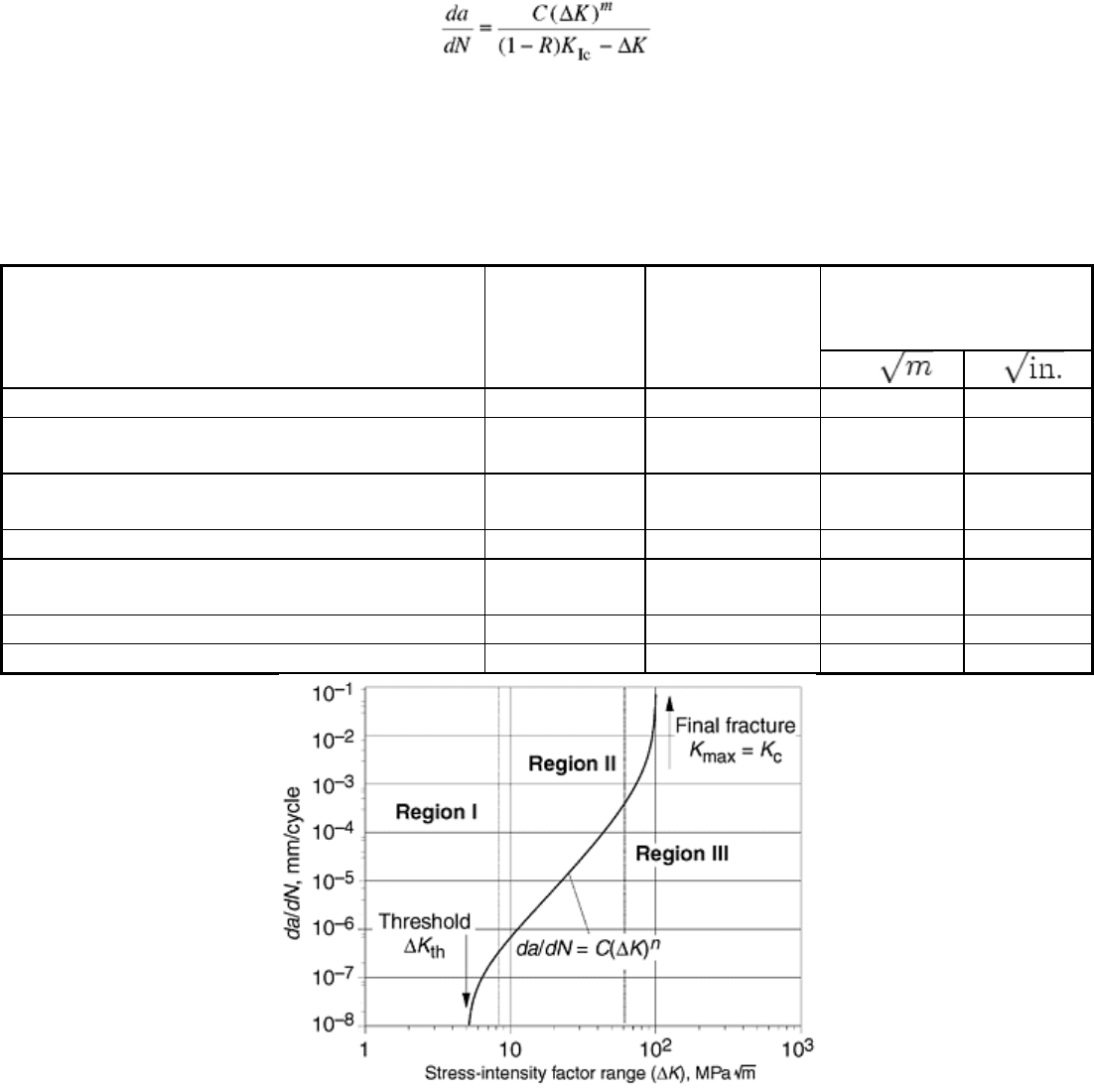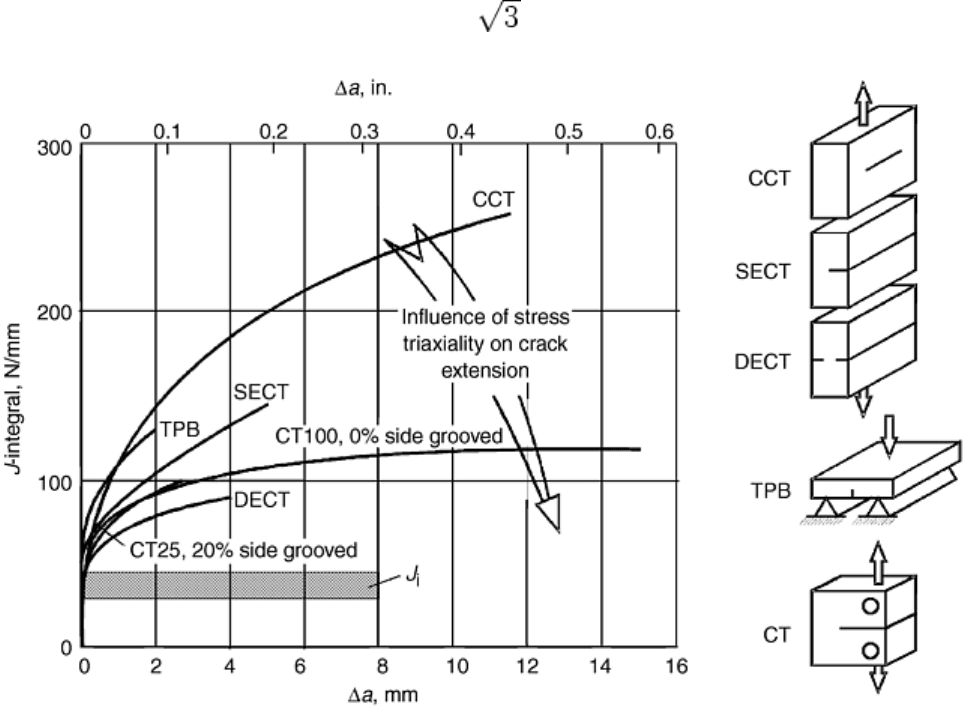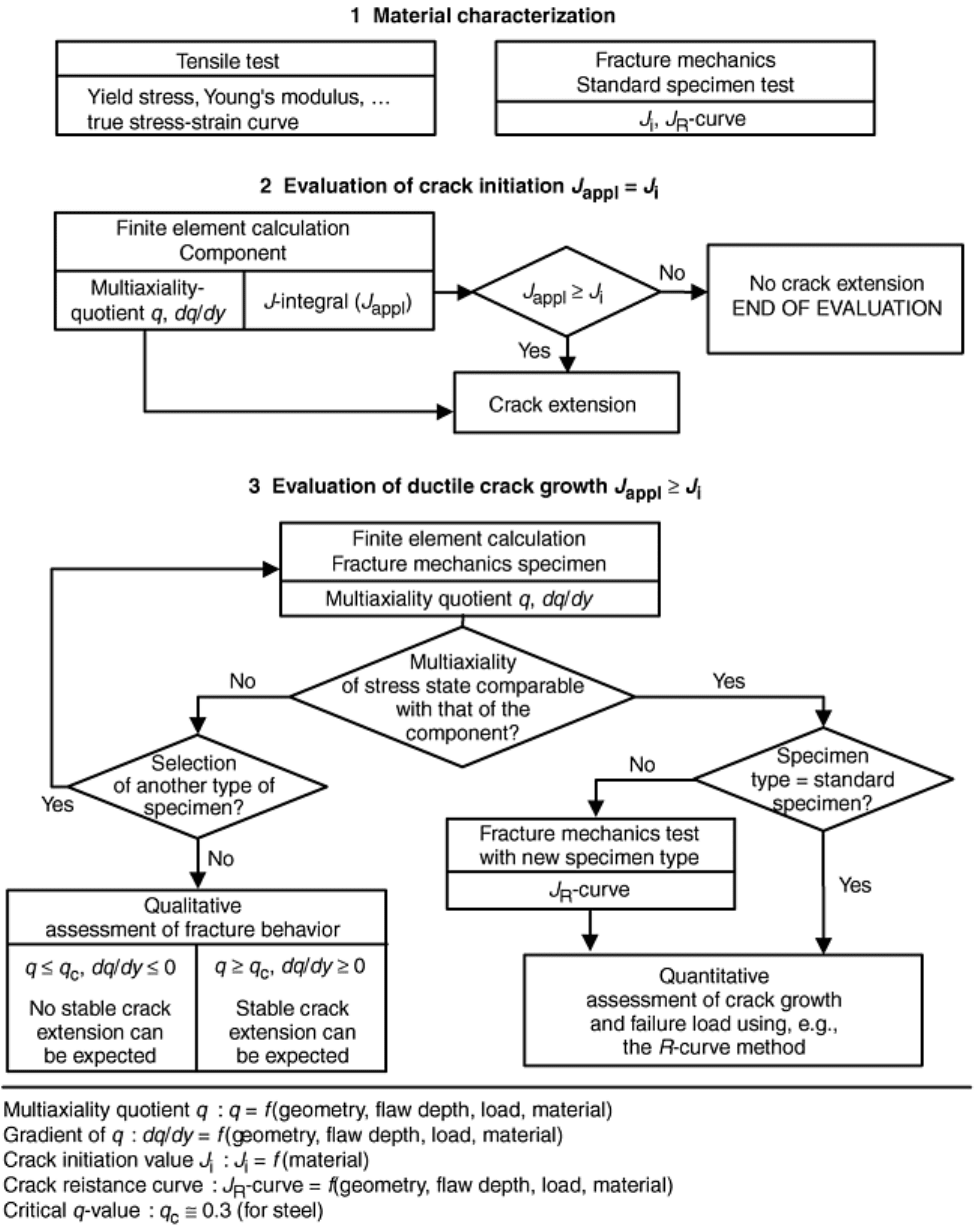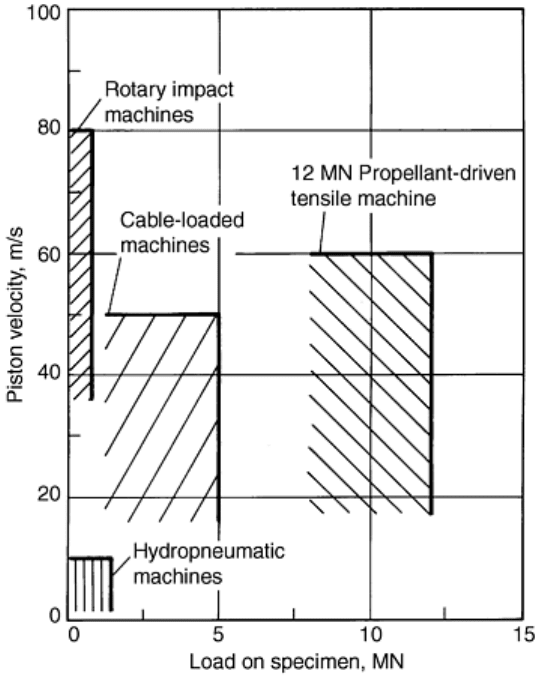ASM Metals HandBook Vol. 8 - Mechanical Testing and Evaluation
Подождите немного. Документ загружается.


and
where K
I
is the linear elastic stress-intensity factor, which is available for different geometries and loading
conditions in the literature, and σ
0
, ε
0
, α, and n are parameters developed by the Ramberg-Osgood
approximation of the true stress-strain curve of the material. The load, F
K
, is the plastic limit load, and h
1
(a/W,
n) is a calibration function evaluated from finite element analyses. Both are given for different geometries (e.g.,
Ref 33, 34).
Initiation occurs at the load at which the crack driving force curve intersects the J
R
-curve of the material at the
initiation value J
i
. The instability load is given by the curve of the crack driving force that forms a tangent to
the J
R
-curve (Fig. 5).
Fig. 5 Application of the R-curve method
Crack Growth Behavior under Cyclic Loading
For components operating under alternating loads, the crack growth under these loading conditions should be
known. The crack growth in a component under alternating loads can be calculated from the loading amplitude,
the number of cycles, and the crack geometry. From the crack size and the loading amplitude, the range of the
stress-intensity factor ΔK/2 can be calculated as follows:
ΔK = f (Δσ, a, f)
The crack propagation rate da/dN for ΔK-values greater than the threshold value ΔK
th
can be calculated by the
well-known Paris law (Ref 35), which has the general form:
da/dN = C (ΔK)
m
A typical curve of fatigue crack propagation is shown in Fig. 6. There are three regions within the curve.
Region I may be referred to as the near-threshold area. Table 1 lists threshold values for selected materials. If
ΔK is smaller than ΔK
th
then da/dN is assumed to be zero. If ΔK is greater than the threshold value ΔK
th
, there
is a crack growth under alternating loads (region II). The Paris law is a good approach, especially for this region
II. In region III, the crack propagation is very progressive. With increasing crack size, the stress intensity
increases and the crack growth rate accelerates until the remaining ligament fails due to instability. Forman's
equation (Ref 36) could describe the fatigue propagation behavior in regions II and III (see Fig. 6) and also
consider the stress ratio. Forman's empirical approach is:

where C, m, ΔK
th
, and ΔK
Ic
are material characteristics determined with standardized test methods (Ref 37).
Environmental conditions and the load range ratio R affect these values. For example, the ASME Boiler and
Pressure Vessel Code (Ref 1) contains some C and m values for different R-ratios of typical steels of light water
reactors.
Table 1 Threshold stress-intensity values for selected materials
Threshold stress-
intensity
value (R = 0.1)
Material ASTM
designation
German
designation
MPa ksi
Carbon steel plate A 573 St 52-3 11.5 10.5
High-strength low-alloy steel A 633, grade
C
StE 355 9.3 8.5
High-strength low-alloy niobium-vanadium
structural steel
A 572 StE 47 9.1 8.3
Titanium alloy Ti-6Al-4V B 265 TiAl6V4 8.3 7.6
High-strength manganese carbon steel pressure
vessel plate
A 455 16 Mn 8.1 7.4
Chromium steel … 30CrMnSiNi2A
3.3 3.0
Aluminum alloys … … 2.5 2.3
Fig. 6 Cyclic crack growth
References cited in this section
1. “Rules for Construction of Nuclear Power Plant Components,” ASME Boiler and Pressure Vessel Code,
Section III, American Society of Mechanical Engineers, 1998
14. K. Kussmaul, D. Blind, E. Roos, and D. Sturm, The Leak-Before-Break Behavior of Pipes, VGB
Kraftwerkstech., Vol 70 (No. 7), July 1990, p 465–477
27. G.T. Hahn, M. Sarrate, and A.R. Rosenfield, Criteria for Crack Extension in Cylindrical Pressure
Vessels, Int. J. Fract. Mech., Vol 8, 1969, p 187–210

28. R.J. Eiber et al., “Investigations of the Initiation and Extent of Ductile Pipe Rupture,” Final report, Task
17, BMI-1866, 1966, and BMI-1908, 1971, Battelle Memorial Institute, Columbus
29. W.A. Maxey, “Fracture Initiation, Propagation and Arrest,” Fifth Symposium on Line Pipe Research,
1974
30. M.F. Kanninen et al., “Instability Predictions for Circumferentially Cracked Type 304 Stainless Steel
Pipes under Dynamic Loading,” EPRI report NP-2347, Vol 1, 2, Electric Power Research Institute,
April 1982
31. I. Milne, R.A. Ainsworth, A.R. Dowling, and A.T. Stuart, “Background to and Validation of CEGB
Report R/H/R6,” CEGB R/HR6-Rev. 3, Validation, Central Electricity Generating Board (CEGB), Jan
1987
32. V. Kumar, M.D. German, and C.F. Shih, “An Engineering Approach for Elastic-Plastic Fracture
Analysis,” EPRI NP-1931, topical report, Electric Power Research Institute, July 1981
33. V. Kumar, M.D. German, W.W. Wilkening, A.R. Andrews, H.G. deLorenzi, and D.F. Mowbray,
“Advances in Elastic-Plastic Fracture Analysis,” EPRI NP-3607, Project 1237-1, final report, Electric
Power Research Institute, Aug 1984
34. A. Zahoor, Circumferential Through Wall Cracks, Ductile Fracture Handbook, Vol 1, EPRI NP-6301-
D, research project 1757–69, Electric Power Research Institute, June 1989
35. P.C. Paris and F. Erdogan, A Critical Analysis of Crack Propagation Laws, J. Basic Eng. (Trans. ASME
D), Vol 85, 1963, p 528–534
36. R.G. Forman, V.E. Kearney, and R.M. Engle, Numerical Analysis of Crack Propagation in Cyclic
Loaded Structures, J. Basic Eng. (Trans. ASME), Vol 89, 1967, p 459
37. “Standard Test Method for Measurement of Fatigue Crack Growth Rates,” E 647-95a, ASTM
Testing of Pressure Vessels, Piping, and Tubing
E. Roos, K.-H. Herter, and F. Otremba, Staatliche Materialpruefungsanstalt (MPA), University of Stuttgart
Transferability of Mechanical Properties
The generally used material characteristics in the design phase and in safety analysis are the strength properties
(yield strength and tensile strength) of the material. Normally, requirements are given in standards and material
specifications for the materials used. Additionally, toughness properties are used for characterizing the material.
Toughness properties are reduction of area and maximum elongation derived from the tensile test and Charpy
V-notch impact energy.
Besides these properties for the assessment of critical crack sizes, fracture mechanics characteristics also have
to be evaluated. The fracture mechanics properties very much depend on the material behavior.
Unlike the calculation of the failure loads by the plastic limit load equations, which are based on the strength
values evaluated from the tensile test, the calculations using fracture mechanics procedures are more
distinguishing because the crack initiation as well as the maximum or instability load can be determined. The
indispensable premise is the transferability of the fracture mechanics characteristics from small-scale

(laboratory) specimens to the components. This could be checked by the parameter that describes the event of
the crack initiation with the same value for the specimen and for the component as well.
Numerous large-scale tests were conducted at MPA Stuttgart to investigate this issue of transferability (Ref 38,
39, and 40). The crack resistance curves were evaluated using large-scale specimens. Crack initiation values
were consequently determined analogous to small-scale specimen tests. The results were verified for the
effective crack initiation value J
i
. The evaluation of this transferable fracture mechanics materials characteristic
is only given in European standards ESIS P1-92 (Ref 41) and ESIS P2-92 (Ref 42).
The transferability, however, cannot be validated for all crack resistance curves (Ref 43). Figure 7 shows crack
resistance curves determined from large specimens of different geometry and size made of the ferritic material
22NiMoCr-3-7 mod. The test temperature was 80 °C (175 °F); that is, the tests were performed at the onset of
the upper-shelf regime of the C
v
-T curve. The crack initiation values J
i
of all specimens fall within a narrow
scatterband, whereas the crack resistance curves demonstrate a significantly divergent behavior with increasing
crack growth Δa. This is due to the distinct difference in the degree of multiaxiality of the stress state because
of the different geometry and size of the specimens. The multiaxiality of the stress state could be quantified
with coefficient of triaxiality (Ref 43):
q = σ
e
/( σ
m
)
where σ
e
is the von Mises equivalent stress and σ
m
= (σ
1
+ σ
2
+ σ
3
)/3.
Fig. 7 Influence of stress triaxiality on J
R
-curves above initiation J
I
. Material: 22NiMoCr-3-7 mod; test
temperature 80 °C (175 °F); ratio of crack length (a) to specimen width (W), 0.5
Therefore, crack resistance curves cannot be regarded as generally valid material characteristics, but instead are
specimen- or component-specific characteristics. The failure process after crack initiation in terms of stable
crack extension is very strongly dependent on and controlled by the stress state, especially by the multiaxiality
of the stress state.
The transferability of the J
R
-curve from a laboratory specimen to a component and the use of the J
R
-curve
within a fracture mechanics concept to calculate the failure behavior (e.g., instability load) is only possible if
the distribution of q values across the ligament is comparable. The process of evaluating the initiation and
instability load is represented in Fig. 8.

Fig. 8 Flow chart for the evaluation of degraded components
The quality of analytical and numerical approaches is highly dependent on the transferability of data developed
by small-scale laboratory tests to the full-scale components. Within the scope of research programs performed
by MPA Stuttgart, large-scale specimen and full-scale components with dimensions similar to the original
components in power plants were investigated to demonstrate the transferability of material data. The following
section describes some specific selected large-scale and full-scale tests and their results relevant to the topic of
this article.

References cited in this section
38. Research Project 150 0270, “Phenomenological Pipe and Vessel Burst Tests, Phase I und II,” Final
Report 150 0279, MPA Stuttgart, Abschluβberichte 1985 und 1987 (final reports in German)
39. Research Project 150 0304, “Integrity of Components, Phase I und II,” Final Report 150 0304, MPA
Stuttgart, Abschluβberichte 1983 and 1989 (final reports in German)
40. Research Project 150 0618, “Pressure Vessels Subjected to Pressurized Thermal Shock Loading,” Final
Report 150 0618, MPA Stuttgart, Abschluβbericht 1990 (final report in German)
41. “Recommendations for Determining the Fracture Resistance of Ductile Materials,” ESIS P1-92,
European Structural Integrity Society (ESIS), Jan 1992
42. “Procedure for Determining the Fracture Behavior of Materials,” ESIS P2-92, European Structural
Integrity Society (ESIS), Jan 1992
43. H. Clausmeyer, K. Kussmaul, and E. Roos, Influence of Stress State on the Failure Behavior of Cracked
Components Made of Steel, Appl. Mech. Rev., Vol 44 (No. 2), Feb 1991, p 77–92
Testing of Pressure Vessels, Piping, and Tubing
E. Roos, K.-H. Herter, and F. Otremba, Staatliche Materialpruefungsanstalt (MPA), University of Stuttgart
Full-Scale Testing
The overall objective for full-scale testing of pressure vessels, piping, and tubing is the proof of integrity and
the leak-before-break behavior. Full-scale testing also provides verification and validation of structural analyses
and fracture mechanics calculations. In the following section, some full-scale testing facilities are described
briefly as an introduction on general capabilities of the facilities. This is followed by a description of typical
test results for various applications.
Requirements and Test Facilities
Quasi-Static (Monotonic Increase) Internal Pressure Loading (Burst Test). Straight pipe sections with an
internal diameter of 700 mm (28 in.) and a wall thickness of 47.5 mm (1.87 in.) and closed on both ends were
used as full-scale test components (Ref 44, 45, and 46). Regarding internal pressure and temperature, the test
conditions were related to the operating conditions of pressurized water reactors. Water was mainly used as the
pressurizing medium and had already been filled in the pipe during the heating process. The internal pressure
was controlled in parallel with the heating temperature so that no steam could develop inside the pipes (for
safety). After reaching the test temperature, the pressure was raised monotonically by further injection of water.
In order to control the time-dependent decay of pressure during the fracture or failure process, the test could
also be carried out under main steam line conditions or those similar to the conditions of boiling water reactors.
Therefore, the test facility was additionally designed for the use of air as a compressible pressurizing medium in
some tests.
Quasi-Static (Monotonic Increase) External Loading. In the case of straight pipes, different types of test
equipment were used for static external bending moment loading:
• A four-point bending device with a capacity of 10 MN · m for pipe dimensions up to nominal diameter
800 mm (31.5 in.) and 50 mm (2 in.) wall thickness (Ref 47) and with a capacity of 3 MN · m for pipe

dimensions up to nominal diameter 400 mm (15.75 in.) and 15 mm (0.6 in.) wall thickness (Ref 48). To
guarantee constant loading conditions in the phase of crack initiation and crack propagation, as well as
to realize a testing system with high stored energy, air was used as a compressible pressurizing medium
in the hydraulic actuators and as a reservoir in the test pipes.
• A constant-moment loading bending device with a capacity of 2 MN · m bending for pipe dimensions
up to nominal diameter 300 mm (11.8 in.) and 35 mm (1.4 in.) wall thickness (Fig. 9), and with a
capacity of 40 kN · m for pipe dimensions up to nominal diameter 80 mm (3.1 in.) and 10 mm (0.4 in.)
wall thickness
The test temperature was ambient (room) temperature up to operational temperature (e.g., 300 °C, or 570 °F).
The pipes were loaded under specified constant internal pressure and a superimposed monotonic increasing
external bending moment.
Fig. 9 Constant moment loading bending device with capacity of 2 MN · m. Inset shows instrumented
pipe after the test
In the case of elbows (pipe bends) depending on the loading mode (in-plane opening or closing, out-of-plane)
different types of test equipment were used for quasi-static external bending moment loading:
• Moment loading for the elbows with nominal diameter 400 mm (15.75 in.) and 30 mm (1.2 in.) wall
thickness was realized by transverse forces at the end of long pipe sections adjacent to the elbows (Ref
49). For the in-plane opening mode, the load was imposed by a 15 MN horizontal-testing device, which
exerted a force combination of normal and lateral force on the pipe together with a bending moment;
however, the long pipe leg meant that the bending moment imposed the dominant stress in the elbow

(Fig. 10). A similar test setup was used for the in-plane closing mode. Out-of-plane loading was realized
by a combined torsional moment and a lateral force. The testing device was set up horizontally (Fig.
11). A hydraulic cylinder was imposed vertically at the long end of the two adjacent straight pipe
sections of different length. A special fixpoint had to balance the forces resulting from the applied
transverse forces of the loading point. In all the different loading cases, the elbow mid-sections were
dominantly stressed by moment loading.
• Elbows with nominal diameter 800 mm (31.5 in.) and 50 mm (2 in.) wall thickness and degraded by
longitudinal flaws on both bend flanks were loaded by constant internal pressure and superimposed
bending moment with in-plane closing mode (Ref 50, 51, 52) (Fig. 12).
Fig. 10 Bending device for elbows (in-plane opening mode)

Fig. 11 Bending device for elbows (out-of-plane opening mode)
Fig. 12 Bending device for elbows with nominal diameter 800 mm (31.5 in.) and wall thickness 50 mm (2
in.)

Dynamic Loading (High-Loading-Rate Tensile Testing). For high-loading-rate tensile testing, several concepts
that differ mainly in the function of the testing equipment and especially in the attained load and maximum
velocity as well as in the velocity history can be used for dynamic tensile tests. Hydraulic and hydropneumatic
testing machines cover the range up to a maximum velocity of about 12 m/s (39 ft/s). Cable-loaded testing
facilities or machines driven by a propellant charge attain 50 to 60 m/s (165–200 ft/s), whereas on rotary impact
machines the velocity goes up to 80 m/s (260 ft/s) (Fig. 13). The velocity of hydropneumatic, cable-loaded
testing machines and rotary impact machines is nearly constant during the test procedure, and full loading is
applied instantaneously. The machines driven by a propellant charge attain the maximum velocity after a
certain stroke, depending on the type and quantity of the propellant charge used, on the volume of the
combustion chamber, and on the masses to be accelerated. This peculiarity allows a more realistic simulation of
actual dynamic loading cases. The mode of operation of a propellant-driven 12 MN high-loading-rate tensile
testing machine (Fig. 14) is shown schematically in Fig. 15 together with an idealized energy diagram. The
energy that is released on combustion of the propellant divides into acceleration energy and deformation energy
until fracture of the test specimen occurs. Subsequent to the fracture, the remaining energy of the accelerated
components is absorbed by deformation of an aluminum damping element.
Fig. 13 Load capabilities of different high loading rate tensile testing equipment
